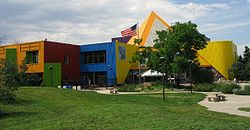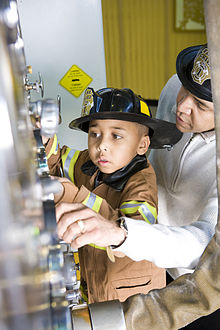- Children's Museum of Denver
-
Coordinates: 39°44′56″N 105°01′01″W / 39.749°N 105.017°W
Children's Museum of Denver 
Established 1973 Location 2121 Children's Museum Drive Denver, CO 80211 Type Children's Museum Website http://www.mychildsmuseum.org The Children's Museum of Denver is a children’s museum located in Denver, Colorado, in the Central Platte Valley. The Museum's mission is to create a community where children, newborn through age eight, and their grownups learn through play. Through interactive exhibits, daily educational programming and special year-round events, children are encouraged to explore, discover, create and learn.
Contents
History
In 1973, a group of parents, educators and Museum administrators organized Denver’s first Children’s Museum to promote curiosity and encourage learning through play. The Children’s Museum started as a modest travelling Museum, and in two years time, moved into a restored turn-of-the-century dairy. At this location, the Museum vastly grew in popularity with about 10,000 visitors per month. The space soon became inadequate for the needs of both the Museum and its staff and in 1979, the Museum decided to build its new facility in the proposed Gates-Crescent Park, along the Platte River. The new location was in a central part of the city, provided accessibility from major traffic arteries, was adjacent to an area suitable for recreational activities and offered adequate parking to the public and staff members. The Museum opened in 1984 in its new location and has remained there ever since.[1]
The year 1997 marked a turning point for the Children’s Museum. Acting on information from the community, the Museum changed its mission, revitalized its organizational culture and established standards that focused on serving newborns through 8-year-olds. With this focus, a first-floor renovation was completed in 2000 and the Center for the Young Child, an exhibit designed exclusively for newborns through age four, opened.[2]
The Museum set an attendance record for the fourth year in a row by serving more than 308,000 children and parents, teachers and other caregivers in FY2011. The Children’s Museum of Denver serves more people per square foot of exhibit space than any other children’s museum in the country.[3]
Museum Philosophy
The Children’s Museum of Denver’s team focuses on five key developmental domains when designing its educational play-based exhibits and programs: hands-on development, social-emotional growth, sensory awareness, language and cognitive development, and large motor development. In addition, the Colorado Model Content Standards[4] and the Colorado Building Blocks are used to support the specific needs of our guests, including students and teachers.
The Museum’s educational focus is built on theories about the importance of play and its potential to support and enhance a child’s development. It is the Museum’s belief that exhibits should be rich with open-ended materials and opportunities for children to learn, solve problems and think critically. Exhibits and programming include content focused on science, literacy, arts, math, geography and world culture, and health and wellness. Through staff facilitation, programs use the play environment to support the development in preschool and K-3 students.
Interactive Exhibits
A distinguishing aspect of the Children’s Museum of Denver is the commitment to developing and fabricating exhibits with an in-house team. To assure well-rounded and educationally sound exhibits, a full-time exhibit team works in conjunction with the education department to create and design new experiences. Exhibits are tested in WillitWorks, a prototyping area within the Museum where children and their grown ups can be directly involved in their creation. In creating a new exhibit, the exhibit team considers factors such as market appeal, elements of play, target age, design and access, childhood developmental building blocks and Colorado Model Content Standards for fine arts, math and language arts.
Alphabet Soup
Alphabet Soup is a giant magnetic wall covered with colorful shapes, numbers and letters in English and Spanish. Children can learn to construct simple words and sentences and identify shapes, letters and numbers. Early learning principles such as written expression, fine motor skills and teamwork are encouraged.
ARTS a la Carte
With an art studio, dance floor and puppet theater, children are encouraged to develop their creativity through open-ended play. The studio offers a variety of tools and materials to create their own works of art. Children learn about rhythm, movement, music and performance on the dance floor. The puppet theater is a place for children to develop their imaginations through role play. Large and fine motor skills, creative thinking, self-expression and social interaction skills are developed in ARTS a la Carte.
The Assembly Plant
Children use recycled materials, donated by community members, to design and build one-of-a-kind creations. Along with their grownups, children can sit at an individual workshop with blueprints and real tools to create something of their own. This exhibit promotes constructive play, hand manipulation of tools, safety knowledge and creative thinking.[5]
Bubbles
Using a variety of tools and machines, guests create bubbles of different size, area, diameter, volume and length. Through this exhibit, children use the scientific method and hone their math skills.[6]
The Center for the Young Child
This exhibit is unique to the Children’s Museum of Denver because of its focus on newborns through age four. The Pond allows newborns through age one to interact with their caregivers in a nurturing setting. The Meadow, for ages nine months to two years, promotes mobility and sensory thinking in a quiet, safe environment. Children ages two to three develop social and motor skills by climbing stairs and going down a slide in the Grove. Within the Village, children ages three to four years learn about gardening, caretaking, fishing and cooking; problem-solving and early literacy skills are promoted.
Click Clack Train Track
Children dress up as conductors to build train tracks and communities, developing hand-eye coordination and critical thinking.
CMD Fire Station No. 1
This exhibit boasts a real Denver Fire Department truck that children can play in and around. In addition to dressing as a firefighter, children learn about preventing fires and calling for help in the Interactive 911 Call Center. CMD Fire Station No. 1 promotes safety and community awareness, and large motor skills.[7]
My Market
Children and their grownups imitate real-life experiences in this child-sized grocery store. They use a grocery cart or reusable bag, choose what food to buy, check out at the cash register, and cook for customers at the pizza kitchen. My Market supports principles such as health and nutrition, community awareness, critical thinking and literacy.[8]
Ready Vet Go
This is a mobile exhibit featuring a kid-sized clinic that allows children to role play as a veterinarian. Using lab coats, real x-rays and exam tools, kids learn about animals and health in a hands-on way. Fine and large motor skills, social and emotional interactive growth and critical thinking are facilitated.
Under My Feet and Over My Head
Children get to experience life as an animal in the Children Museum of Denver’s own kid-sized backyard. In a playful natural habitat, children learn about animal survival habits through the perspective of different creatures. This exhibit promotes science, problem-solving, and creative thinking.
Programming and Events
In addition to exhibits, the Children’s Museum of Denver offers daily educational programming. These programs match the Museum’s monthly theme, such as Wild West Month, Stellar Science Month and Get Caught Reading Month. Daily programming subjects range from fine arts to science and offer age-specific activities for toddlers and school-age children. The Museum also offers special family events to guests, such as Bunny Trail EggVenture, Trick or Treat Street and Noon Year’s Eve. Additionally, the Museum pairs with other cultural organizations in collaborative learning events that occur throughout the year.
Outreach Programs and Group Visits
The Children’s Museum of Denver offers educational opportunities for groups within the Museum and in the community at schools, organizations, festivals and more. School groups attend field trips to the Museum for facilitated educational programs, which can also be brought to the school classroom and taught by Museum staff. Programs are designed to support Colorado Model Content Standards in life science, earth science, reading and writing, math and music, in addition to Colorado's 21st Century Skills of self-direction, critical thinking, invention, collaboration and information literacy.[9]
G.R.O.W. Science and Literacy Collaborative
The G.R.O.W. (Growing Respect by Observing our World) Collaborative between the Children’s Museum of Denver, the Butterfly Pavilion and Denver Botanic Gardens, brings these educational organizations to Denver and Adams County elementary schools in underserved neighborhoods. G.R.O.W. utilizes an integrated curriculum that includes classroom instruction, teacher workshops, an outreach visit to each school, a Museum field trip, a series of family nights at the Museum and an annual membership to each institution. The curriculum helps to meet Colorado Model Content Standards to build science and literacy skills while fostering respect and compassion in students, families and teachers for all living things. The entire collaborative served 57 classrooms in 6 schools and roughly 1,425 students in FY2010.
Sponsored Admissions
The Children’s Museum of Denver offers a Sponsored Admissions and Memberships Program to low-income children. The program is funded by grants and the Helen McLoraine Children’s Museum of Denver Endowment Fund. In FY2011, the Museum provided 14,800 free admissions, bus transportation and memberships to children from predominantly low-income elementary schools and childcare centers. This was up 500 children from FY2010.[10] Additionally, the Museum participates in the City of Denver’s 5 By 5 Project, which enhances learning for Denver’s Head Start children by offering annual memberships at many of the city’s cultural facilities.[11] More than 2,300 Head Start children and their families explored the Museum through the 5 By 5 Project in FY2011, up from 1,800 in FY2010.
Target Tuesday Nights
The Children’s Museum of Denver offers free admission once a month through a partnership with the Target Corporation. The first Tuesday evening of each month from 4-8 p.m. is free to the public. In all, more than 47,500 people have visited free since Target Tuesday Nights began in February 2007.[12]
Organization
The Children’s Museum of Denver is a 501(c)(3) private non-profit organization and a Tier II Scientific and Cultural Facilities District[13] member. As an organization, the Museum strives to raise 50 percent of its revenue through fundraising events, grants, donations and corporate sponsorships and earn 50 percent of its revenue through admissions, facility rentals and membership sales.
A board of directors acts as advisers for the development of the Museum within the Denver community. A Museum Leadership Team is led by a President and CEO and consists of a Chief Museum Officer, Chief Financial Officer, Vice President of Development and Communications, Director of Facilities, Senior Director of Guest Services and Facilities, and a Director of Education. About 30 full-time and 15 part-time employees work for the Children’s Museum of Denver.[14] Additionally, hundreds of volunteers give their time to the Museum annually.
References
- ^ The NEW Children’s Museum on the Platte River: A Readable, Concise Proposal. 1981.
- ^ 2002-2003 Annual Report, Children’s Museum of Denver.
- ^ 2008-2009 Annual Report. Children’s Museum of Denver.
- ^ Colorado K-12 Model Content Standards. Accessed on July 13, 2010. http://www.cde.state.co.us/cdeassess/UAS/OldContentStandards.html
- ^ "Children's Museum of Denver." Denver Daily News 10 February 2010: 5. Print.
- ^ Wenzel, John. "Science Exhibit Catches Kids on the "Bubbles"" The Denver Post 14 May 2010: 1D+. Home - The Denver Post. 14 May 2010.
- ^ "Grandplay - Firehouse Field Trip." Prime Time for Seniors [Louisville, CO] 1 April 2010: 18. Print.
- ^ "Make the Right Choice." The Villager [Greenwood Village, CO] 25 March 2010: 3. Print.
- ^ 2005-2006 Annual Report. Children’s Museum of Denver.
- ^ Press Release. August 10, 2009. Children’s Museum of Denver.
- ^ The 5 By 5 Project. City of Denver. Accessed on July 13, 2010. https://www.denvergov.org/5_By_5/HomePage/tabid/377683/Default.aspx
- ^ "Free Days." 5280 2 January 2010: 44. Print.
- ^ Scientific and Cultural Facilities District. Accessed on August 2, 2010. http://www.scfd.org
- ^ Fact Sheet 2009. Children’s Museum of Denver.
Categories:- Children's museums in Colorado
- Museums in Denver, Colorado
Wikimedia Foundation. 2010.

